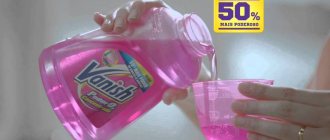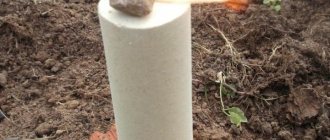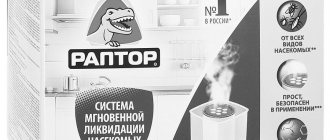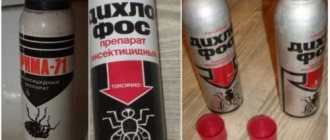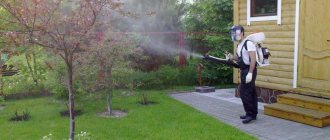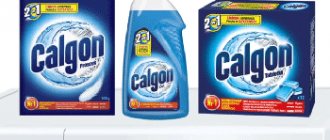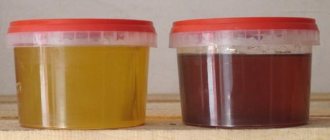Owners of dachas, country cottages and private houses with farmsteads are often bothered by mice and rats, which begin to appear in the fall or closer to winter. Just as in the famous fable, a dragonfly tries to spend the winter with an ant, so rodents from fields, gardens and forests smoothly move into houses and utility rooms, where they can profit from the harvest. Among them are field and house mice, black and gray rats. To keep their property and food intact, owners begin to fight rodents. And the poison Rat Death helps them in this.
Composition of the drug
Rat Death poison is available in two forms - Rat Death 1, Rat Death 2. The main difference is in the active ingredient. The first drug uses brodifacoum, the second - bromadiolone.
Brodifacoum is more toxic; a small dose is enough to poison an animal. Bromadiolone acts more slowly, but the results are impressive.
The first drug is released in blue-green tones, the second one resembles pieces of meat. The following are used as auxiliary components:
- flour;
- vegetable oil;
- nutritional supplements;
- flavorings.
The toxic substance does not reveal itself in any way. Rats eat the bait with great eagerness and a huge appetite. Since the product does not begin to act immediately, pests do not see anything suspicious in the treat. All that remains is to add more poison to the rats and wait for the result.
Prohibited poisons
Pesticides that threaten the life and health of people and harm the environment are included in the “black” list. Among them:
- Arsenic is a substance that depresses the nervous system and causes severe pain in the digestive tract. Provokes paralysis, pulmonary edema, coma.
- Strychnine - causes paralysis of the respiratory center, which leads to death.
- Yellow phosphorus - when it enters the body, it affects the circulatory system, brain, and liver.
- Lead - accumulates in bones, damages the brain and kidneys. High doses of metal lead to death.
The use of these substances in rodent control is prohibited in many countries.
Release form
Poison Rat death
The effectiveness of the poison largely depends on the form of release. Rat Death is produced in the form of a gel-like substance. It is given the appearance of a briquette and packed in filtered paper. Placed in a polymer film. Poison in bags is stored for 3 years from the date of manufacture.
On a note!
A special gel base prevents the product from losing its properties while remaining on the floor surface for a long time. Sun rays and high temperature do not affect the appearance of the drug. The recommended period for using printed briquettes is 2 weeks.
An effective rat repellent can be purchased at any specialty store at an affordable price. The package contains 8 briquettes weighing 100 g, or 16 pieces with a total weight of 200 g. The active composition of the rat repellent and the successful release form have made the poison in demand on the market for similar products.
Conclusion
Poisons are an effective means of controlling rodents. Facts about them:
- Poisons for mice differ in the way they affect the body. Blood anticoagulants cause internal and external bleeding, leading to death. Other organic poisons cause suffocation and infect with pathogenic bacteria.
- Inorganic pesticides have a highly toxic effect not only on rodents, but also on other animals and humans. They are prohibited for home use.
- You can make homemade poison for mice at home or purchase it at a store or veterinary pharmacy.
- Highly toxic poisons are prohibited for use.
- Mice must be poisoned in compliance with safety measures.
- The most effective poisons cause 100% lethality in rodents.
Rodenticides can be used to kill and prevent rodents.
Effect of the drug
Rat death, according to customer reviews, is one of the best rodent repellents on the market today. The secret of a positive result lies in the active ingredients.
Effect of the drug
How the poison works: brodifacoum and bromadiolone are anticoagulant rodenticides. Once in the animal’s liver, the substances interfere with the production of vitamin K, which is necessary to ensure normal blood clotting. A large dose of anticoagulants causes internal bleeding.
Death occurs within 3 days from the moment of eating a large dose of the drug or within a week if the drug is taken in small doses. The active components are not excreted in urine and accumulate in the animal’s body. Having reached a lethal dose, bleeding begins.
On a note!
Rat death belongs to the second generation coagulants. Unlike its predecessors, it is not addictive in rodents; death can occur when a small dose of poison enters the animal’s body. The lethal dose from Rat Death 1 for mice is 0.24 g, rats - 2 g. To kill pests with Rat Death 2, mice need to consume 0.6 g, rats - 6 g.
During the course of a day, an adult rat eats 50 g of food, a mouse – 5 g. With a high probability, a hungry animal will eat a lethal dose of rat poison in 1 day.
General information
Rats, moving around the apartment, can spoil food and contaminate them and surfaces with their waste products. They can also chew furniture and electrical wiring, which can lead to fires.
IMPORTANT! The greatest harm from rats may lie in their ability to carry diseases that are very serious for humans, which include plague, leptospirosis, hemorrhagic fever, and rabies.
For this reason, you cannot hesitate when fighting rats, otherwise you can expose yourself and your household to great risk.
Operating principle and release form
The described drug is produced in Ukraine using raw materials from Italy. It is capable of destroying both mice and rats.
The product is available in two forms, which are quite effective. The characteristics of both forms of this drug are described in the table:
| Category | "Rat Death" | |
| Number 1 | Number 2 | |
| Main active ingredient | Brodifacoum is an anticoagulant that inhibits blood clotting | Bromodiolone is a more powerful anticoagulant |
| Toxicity level | Average | High |
| Appearance | Blue-green substance | Red substance |
| Lethal dose for one individual | 2 g | 6 g |
| Date of death | 4-8 days | |
| Danger to the environment | Very high | Average |
Although the drugs have different active ingredients, both are effective and give equally good results.
REFERENCE! There is another version of the drug on sale, which is presented in the form of glue. Rat death glue is sold in tubes of 135 g. It differs in that it can only fight mice.
Other components
The drug “Rat Death” is produced in the form of briquettes with a dough-like structure. They are packaged in special bags that allow odors to pass through well. Due to the fact that the active ingredients have no aroma, the composition contains special additives that help attract rats. These include:
- flour;
- sugar;
- vegetable oil;
— flavors of natural origin.
REFERENCE! According to reviews, the described drug has a mummification effect. But the manufacturer himself does not talk about this, and the drug does not contain the corresponding substances.
Terms of use
The instructions for use clearly describe the requirements and possibilities of using the product. It is necessary to follow the recommendations exactly. Violation of the instructions leads to negative consequences, a health problem.
- Think about where you can place the bait indoors so that rodents will immediately notice it. Prepare the required number of cardboard boxes measuring 10*10 cm. Instead of cardboard boxes, you can use a tin lid.
- Wear rubber gloves, arm yourself with a toothpick and tweezers.
- Use your tools to remove the filtered bag of poison and place it on the prepared surface. There is no need to unfold it; rodents can easily cope with this task on their own. To kill mice, add 1 briquette; rats need 2 briquettes.
- The prepared mixture of poison and additives is placed near rodent burrows, in possible places of movement. An effective location for killing mice is 2-5 m from each other. Rat baits are placed at a distance of 4-15 m.
Pests intensify their activity in the dark. In the morning you should check all the baits. Place a fresh briquette in place of the one eaten.
Use of poison
On a note!
The death of rats occurs somewhat later than that of mice. You will have to wait 1-2 weeks for the result. You can tell that the rodents have been exterminated by the appearance of the bait. If, after active devouring in the previous days, the briquette remains untouched, it means that the remedy has begun to work. Pests are dying en masse.
The remaining poison is collected in a plastic bag. Close tightly and bury in the ground to a depth of at least 0.5 m. It is strongly recommended not to throw it in trash cans, since yard dogs, cats, wild animals, and birds can detect the toxic agent. The discovered corpses of rodents should also be buried so as not to poison other animals. The disadvantages are that it is impossible to predict where a rodent will die, and getting rid of the smell of a dead rat is not so easy.
How to cook at home?
You can make compounds that are harmful to rodents yourself. No poisons are used in the mixtures, so they are safe for pets and people.
Homemade poison for mice is prepared according to the following recipes:
- Mix sugar and lime in equal proportions and spread along the walls, near the holes.
- In a ratio of 1:1, combine flour and gypsum (alabaster). Be sure to leave a container of water and milk near the bait. After the rodent drinks the mixture with water, death will occur.
- Mix boric acid (15 g), rosin (20 g) and powdered sugar (20 g).
To attract rodents, aromatic pieces of food (seeds, smoked lard) are added to the compositions. Traditional methods cannot completely rid an apartment of mice; they should be used in conjunction with traps.
Safety regulations
Rat poison is not harmful to humans when used correctly. When working with a toxic product, you must wear rubber gloves and avoid touching your eyes, nose, and mouth. After work, throw away gloves and wash your hands with soap.
The active components are not released into the air and do not affect the well-being of people or pets. Negative consequences are possible if Rat Death enters the stomach. If the minimum dose of the drug is accidentally injected, the liver will deactivate the effect of the poison on its own.
A threat to life occurs when the product is purposefully consumed. This situation is typical for young children who are left unattended by their parents. Rat poison is not excreted through the kidneys, so there is a risk of internal bleeding.
Symptoms of poisoning in humans:
- nausea;
- weakness;
- dizziness;
- loss of consciousness;
- headache;
- pale skin;
- increased or slowed heart rate;
- decreased blood pressure;
- nose bleed;
- blood on the gums, red urine, stool.
The antidote to Rat Death is vitamin K or Vicasol. It is administered intravenously on an outpatient basis for 15-30 days. The complexity of the situation depends on the person’s age, the presence of chronic diseases, immunity, liver and kidney health. Providing timely medical care can save a person from death.
Main types of toxic substances and symptoms of poisoning
A complete list of symptoms of poisoning can only be determined depending on the type of poison that was used to make poison for the rodent. The following types of toxins can be used:
- 1st generation rodenticides;
- 2nd generation rodenticides;
- ratsid;
- vitamin D3;
- zinc phosphide.
Symptoms of a dog being poisoned by a particular group of poisons may vary. It is their determination that will help the veterinarian choose the right antidote and save the animal.
Intoxication with 1st generation rodenticides
Intoxication with 1st generation rodenticides disrupts the dog’s blood clotting process (due to impaired vitamin K synthesis).
Signs of poisoning by this group of substances are as follows:
- thirst;
- frequent urination;
- general weakness;
- decreased appetite;
- bad breath.
Intoxication with 2nd generation rodenticides
In case of poisoning with 2nd generation rodenticides, the same symptoms are observed as with substances of the first group, but with the addition of:
- urinating pink urine (a sign of impaired kidney function);
- redness of the eyes (indicates high blood pressure);
- blood with foam when coughing;
- dark stool of liquid consistency;
- black vomit;
- nosebleeds (as a result of poor blood clotting).
The first thing to appear is blood from the nose. It is this symptom that allows the owner of the animal to suspect poisoning by rat poison. The dark color of stool and vomit is due to the fact that a reaction of gastric juice and blood occurs in the body. The blood coagulates as a result of a reaction with hydrochloric acid and becomes dark in color.
The dog was poisoned by a rat
Vomiting in a dog
The main signs that a dog may have been poisoned by rats:
- cough;
- poor pulse;
- severe vomiting;
- absolute absence of urination.
Intoxication in dogs with zinc phosphide
Zinc phosphide is a strong toxin, including for the human body. It is used exclusively under the supervision of specialists for deratization. In most cases, zinc phosphide is used by specialized organizations. When zinc phosphide enters the stomach, a reaction occurs, releasing a dangerous gas. The amount of gas depends not only on the poison consumed by the dog, but also on the amount of food eaten. The gas that forms in the stomach provokes the following symptoms:
- flatulence;
- panic attacks;
- shock;
- abdominal pain;
- impaired coordination of the dog’s movements (possibly staggering when walking);
- disturbance of consciousness;
- convulsions (long-term, not eliminated by anticonvulsants).
Vitamin D3 poisoning
Vitamin D3 poisoning, at first glance, seems impossible due to its general usefulness. However, extremely high dosages are used to kill rodents. Vitamin D3 poisoning sharply increases the concentration of P and Ca in the blood, causing kidney problems and death of the animal.
Symptoms of vitamin D3 poisoning:
- bad breath;
- frequent urination;
- general weakness;
- a sharp decrease in appetite.
It should be noted that signs of vitamin poisoning appear only 2–3 days after the dog ingests the poison.
The dog's blood is taken for analysis.
Despite the wide range of symptoms of rat poisoning in dogs, diagnosing such poisoning can be quite difficult. This is due to the fact that some of the listed symptoms may be signs of other diseases, including infectious ones. When an animal consumes poison, there is a high risk of treating other diseases rather than poisoning. The most accurate way to confirm poisoning is to have your dog tested by a veterinarian.
How to use rat and mouse poisons with anticoagulants
Despite the absence of mummifying agents in the compositions, anticoagulants speed up the drying process of corpses. An anticoagulant is a drug that interferes with blood clotting and prevents the formation of platelets. The impact on the body causes profuse internal bleeding - severe blood loss significantly reduces the percentage of fluid content, the corpse dries out much faster. It is this effect of anticoagulants that manufacturers of mouse poison present as mummification.
Individuals that have eaten bait with poison return to the nest and slowly die within 10 days. Due to the low moisture content, the tissues of the corpse dry quickly, there is no smell, the problem of decomposition is eliminated, the owner is satisfied. Moreover, rats do not associate effect and cause, and since the animal does not emit an odor, the bait can be scattered again until the next generation of rats with immunity to poisons grows up.
Basic safety requirements:
- The drugs are extremely toxic, so they are laid out on a substrate in the form of cardboard or a lid. It is prohibited to place bags on the floor.
- You cannot touch poisons with your hands; they can only be removed with tweezers and gloves.
- The poison for mice is laid out like this - divide the bag in half, carry it at a distance of 5 m. For rats, take 1 bag for each hole, carry it at a distance of up to 10 m.
- The bait is checked daily and refilled. If poison is used in the house, it is left out only at night.
- A week after applying the first dose, inspect secluded places for rodent corpses. The remains are destroyed by burning or buried in the ground.
- Bait is placed in hard-to-reach places, placed in boxes or containers. This makes it more likely that the rat will not get out of the container; you won’t have to look for it behind the walls, etc.
Particular caution is needed in families with children and pets. An attractive smell can provoke a test, and this is fraught with irreversible consequences. At the slightest suspicion of poisoning, you must immediately call an ambulance and consult a veterinarian.
Signs of human poisoning:
- vomiting, nausea, abdominal pain, diarrhea, headaches;
- impaired hearing and vision, loss of orientation in space;
- blue lips, pale skin;
- weakness, decreased blood pressure;
- increased heart rate;
- the appearance of blood from the gums and nose;
- blood in feces, urine.
First aid for the victim is gastric lavage. Drink up to 1.5 liters of water and induce vomiting. While the ambulance is on its way, the rinsing is done three times. If the estimated time for the poison to enter the body exceeds 10 minutes, take activated carbon at the rate of 1 tablet per 10 kg of person’s weight. To speed up the action of the sorbent, grind the tablet into powder and give it to drink.
Don't hesitate to call for help. Service phone number 112, 103. A person with a diseased liver, gastrointestinal dysfunction, or a child cannot survive without doctors; the use of anticoagulants is extremely dangerous.
Plastic container for mice
In order for poisoned baits to have maximum effect, special plastic bait containers should be used. They are used by pest control agents.
Their advantages:
- the poisonous bait is protected from atmospheric influences (wind, rain);
- equipped with a drinking bowl and a special place for poison;
- To attract the attention of rodents, the entrance resembles a hole.
Poison reserves can be easily and conveniently replenished; this is exactly what the design is designed for.
Bromadiolone
Poison of the anticoagulant group. Once in the stomach of a rodent, it disrupts the synthesis of proteins of the prothrombin complex. Supplied as a liquid concentrate (0.25%) in 1.1 liter containers. In addition to the food base, attractants are recommended: unrefined sunflower oil, sugar. Any operations (cooking, laying out) are performed in special clothing and gloves.
Mass pest control products are toxic and 100% effective only when used correctly, so only certified specialists can use them. In this case, they are safe and the goal will be achieved.
Original Death of the Rat and counterfeits
Today in Russia, at most points of sale, it is not the original Rat Death that is sold, but its analogue, produced under the Tigard brand. In fact (strictly speaking), this poison is a counterfeit, although its composition is identical to that of the original drug and it has the same effectiveness.
The photo below shows the drug Rat Death No. 1 in the original packaging from Ital Tiger:
And the next photo shows us the poison produced by Oboronkhim, Russia:
The photo clearly shows that the packaging design is almost identical, so an inexperienced buyer will not notice the difference at all.
Partly, the need to create counterfeits is related to economic restrictions on the sale of Ukrainian products in Russia. In particular, in Moscow, St. Petersburg and other large cities today it is almost impossible to buy the original Rat Death.
Perhaps the only obvious drawback of the counterfeit (besides the somewhat unethical use of the name and emblem with a similar design) is the assurance on the packaging that Rat Death has a so-called mummifying effect. And many buyers count on this effect of the drug, which supposedly will prevent the spread of odor from dead rats, and willingly buy the product.
In reality, the poison does not have any mummifying effect and does not protect against the appearance of odors in the room. Today, in the market of rodenticides, it has generally become quite fashionable to attribute mummifying properties to drugs, since this advertising ploy is good at spurring demand. What’s interesting is that the mummification effect is often claimed by companies that only package and distribute the products, while manufacturing companies (in most cases foreign) do not mention mummifying properties in the instructions at all. And where will they come from if the poison simply does not contain substances that could stop the decomposition of corpses...
Review
“We met rats when we moved into an old house; they climb up to our second floor and don’t let us live. Having a cat doesn't affect them. We bought rat death N1, a small package, it cost 60 rubles. The tablets were placed in several places and the rats disappeared within a week. And a few days later a terrible stench appeared in the room, as I understood, this poor fellow began to rot somewhere. I had to endure the terrible stench for a long time, it’s not clear where she died...”
Elvira, Kazan

